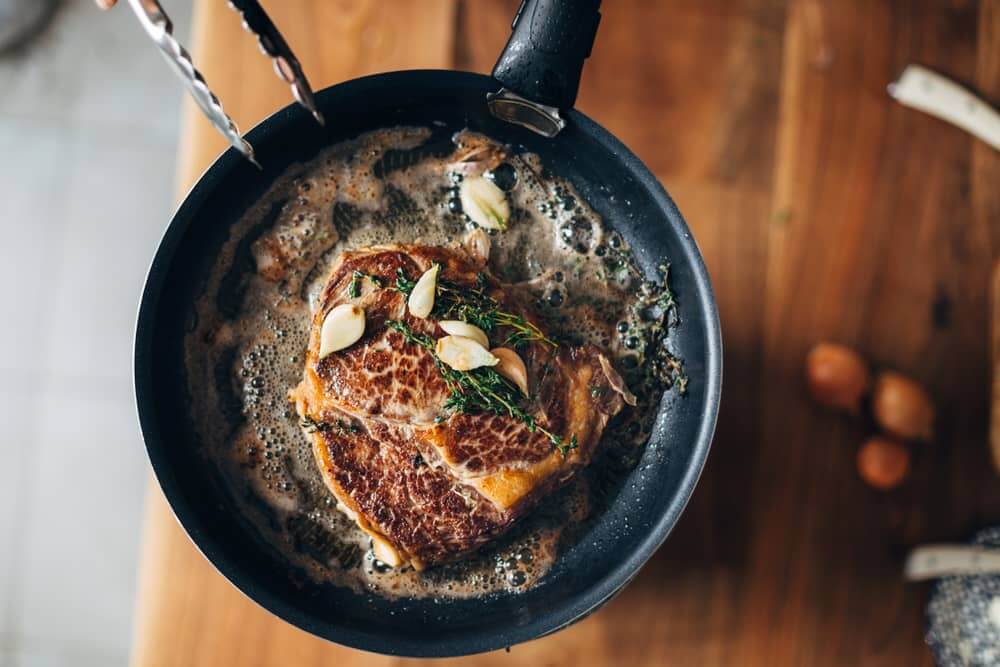
Learning how to cook ribeye in a pan is as easy as following four simple steps that deliver on texture and flavor. Using medium heat is crucial for even cooking and achieving a brown, caramelized exterior. Whether you love bone-in or boneless ribeye, you can get a delicious ribeye steak seared to perfection in just a few minutes. Season the ribeye steak generously with salt and pepper to enhance its flavor before cooking. Use our guide to learn exactly how to do it.
Choosing the Right Cut of Ribeye
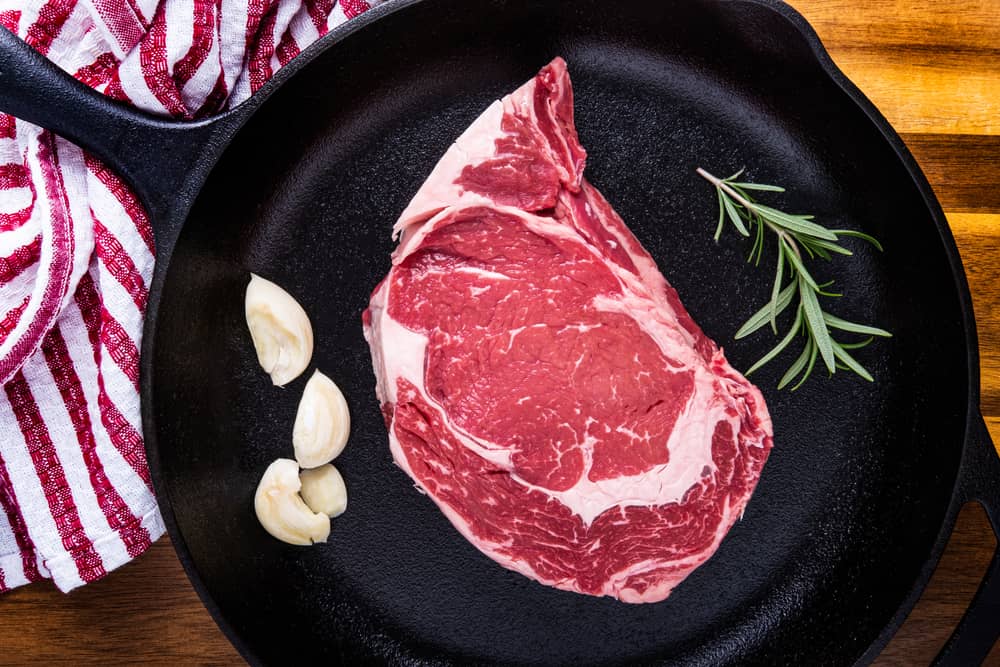
When it comes to ribeye, there are several kinds to choose from. One of the first choices you’ll need to make is whether to get bone-in or boneless ribeye. Bone-in takes longer to cook and usually requires you to finish it off in the oven after searing. Otherwise, many experts explain that bone-in and boneless steaks are relatively indistinguishable. So, choose the one that appeals to you most. Choosing the right cut is essential to cook ribeye steak perfectly.
You’ll also need to decide on a steak quality. We highly recommend USDA Prime or Wagyu ribeye for pan-searing. Because you’re not using a long period of time to cook the steak, you don’t have much wiggle room for tenderizing the steak. A wet-aged or dry-aged steak marked as USDA Prime or Wagyu is already top quality, so you can expect deliciously tender results.
Preparing the Ribeye
Preparing your ribeye steak properly is the first step to achieving a delicious and juicy steak. Start by bringing the ribeye steak to room temperature. Leave it out for about 30 minutes to an hour before cooking. This helps the steak cook more evenly and prevents it from cooking too quickly on the outside while remaining undercooked inside.
Next, season your ribeye steak generously with freshly ground black pepper and kosher salt. For an extra burst of flavor, you can also add garlic powder or paprika. Make sure to sprinkle the seasonings evenly on both sides of the steak, pressing them in gently to ensure they adhere well.
Finally, pat the steak dry with a paper towel to remove any excess moisture. This step is crucial as it helps create a better crust on the steak when it’s cooked, locking in those delicious juices and enhancing the overall flavor.
Cooking Equipment and Pan Selection
Choosing the right cooking equipment is essential for cooking a delicious ribeye steak. A cast iron skillet or cast iron pan is ideal because it retains heat exceptionally well and can achieve a beautiful crust on the steak. If you don’t have a cast iron skillet, a stainless steel or carbon steel pan can also work well. However, avoid using a non-stick pan as it can’t achieve the same level of crust on the steak.
Before adding the steak, make sure the pan is hot. You can test the heat by flicking a few drops of water onto the pan. If they sizzle and evaporate quickly, the pan is ready. This ensures that your ribeye steak will sear perfectly, creating that delicious crust we all love.
Ribeye Pan Searing Tips with Cast Iron Skillet
Use the following tips to learn how to cook ribeye in a pan like a professional steakhouse chef.
Rest Before and After Cooking
The resting period before pan-searing ribeye helps the steaks rise in temperature, resulting in more thorough cooks from the inside out. It also allows the salt to brine the steak, giving it a crispier texture when you sear it.
Resting steaks after cooking happens for a different reason. During these 5-10 minutes, your steak continues to cook after removing it from the heat, bringing it to your ideal temperature. This is why you remove ribeye steak from heat when it reaches a lower temperature than what you’d like the final temperature to be. Juices also reabsorb into the steak to enhance flavor and texture.
Use Butter When Searing
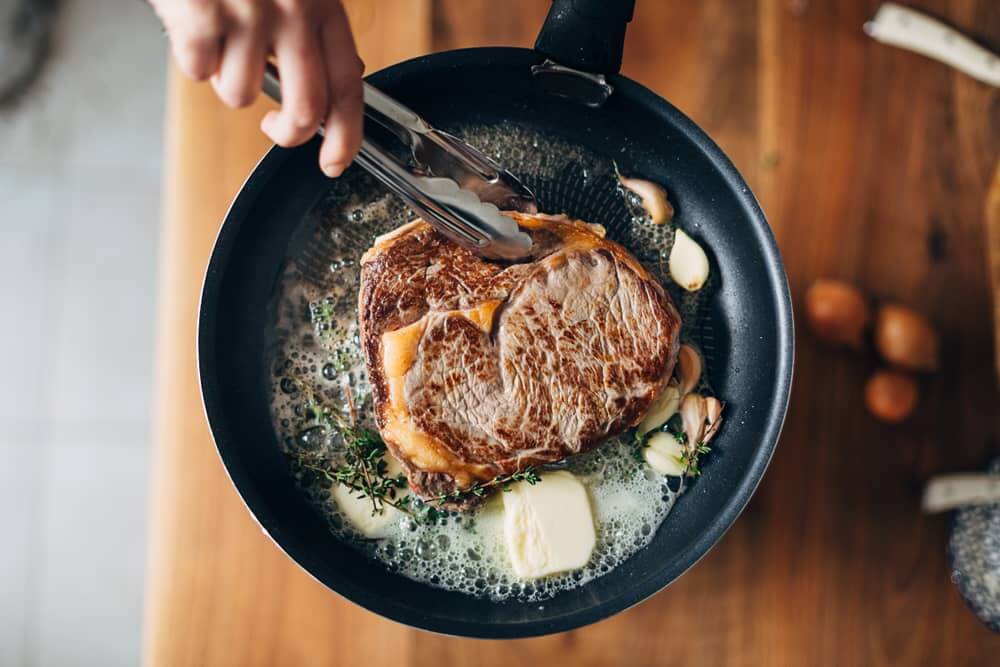
We typically preheat a skillet in oil and use this oil to keep steaks from sticking to the pan. However, you’ll also want some butter on hand to add to the pan during the searing process. While searing, spoon the butter over the ribeye to keep the top of the steak hot and moist, preventing overdrying and letting the heat distribute more evenly. It also adds a light buttery flavor to ribeye.
Use a Thermometer for Accuracy
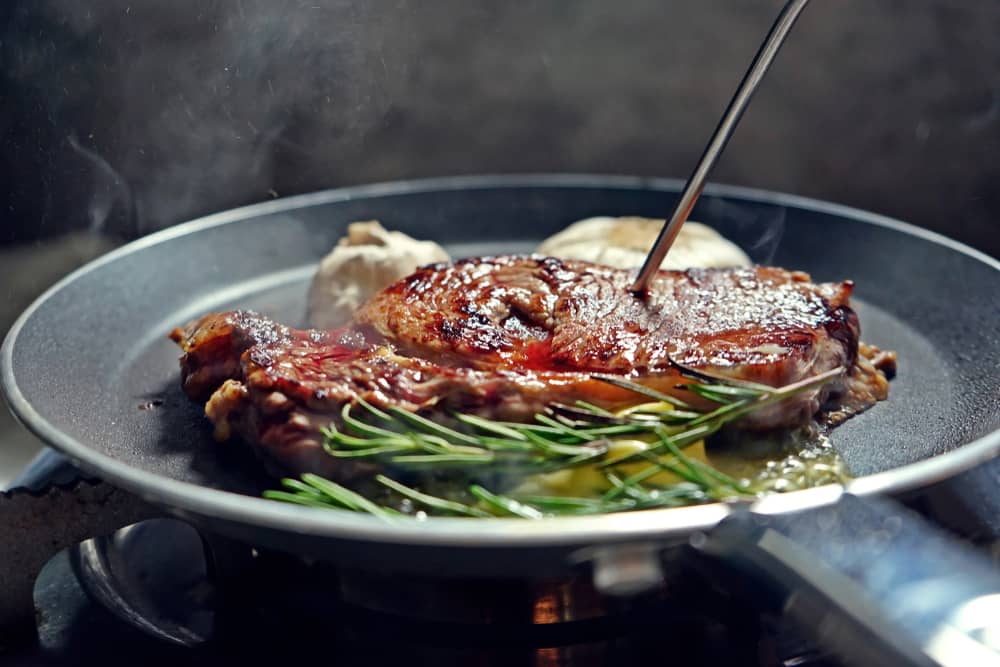
Don’t rely on your fingers or eyes to tell whether a ribeye is done cooking. A thermometer is the only reliable tool to do so. Insert the thermometer probe into the thickest part of the ribeye to check the temperature before removing the steak from the pan. Your thermometer should read 2-5 degrees below the final temperature range for the doneness level you want. For reference, here are the final temperature ranges your steak should reach after resting:
- Medium-rare: 130°F-135°F
- Medium: 140°F-145°F
- Medium-well: 150°F-155°F
- Well-done: 160°F-165°F
Pan Seared Ribeye Recipe
Pan-searing a ribeye steak is a fantastic way to bring out its rich flavor and create a delicious crust. Here’s a simple recipe for pan-seared ribeye:
Ingredients:
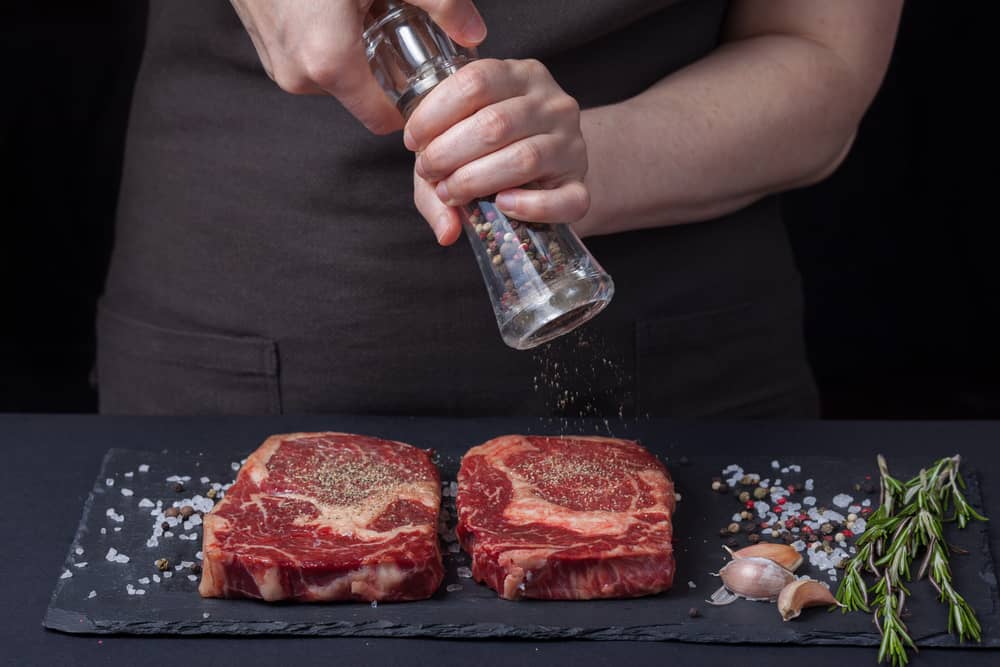
- 1 or more ribeye steaks (about 1 inch thick)
- Salt and freshly ground black pepper, to taste
- 1-2 tablespoons of olive oil or unsalted butter
- Optional: minced garlic, fresh herbs (such as rosemary or thyme)
Instructions:
- Preparation:
- Take the ribeye steaks out of the refrigerator and let them sit at room temperature for about 30 minutes before cooking. This allows for more even cooking.
- Seasoning:
- Pat the steaks dry with paper towels to remove excess moisture. Season both sides generously with salt and freshly ground black pepper. You can also add minced garlic or fresh herbs if desired, pressing them into the surface of the steak.
- Preheat the Pan:
- Heat a heavy-bottomed skillet (preferably cast iron) over medium-high heat. Add olive oil or unsalted butter to the pan and let it heat until it shimmers or the butter foams. Make sure the pan is hot before adding the steaks to ensure a good sear.
- Searing:
- Carefully place the seasoned steaks in the hot pan. Be cautious of oil splatter.
- Let the steaks sear without moving them for about 3-4 minutes, depending on the thickness of the steak and your desired level of doneness. For a medium-rare steak, aim for an internal temperature of 130-135°F (54-57°C).
- Use tongs to flip the steaks and sear the other side for another 3-4 minutes. Adjust the cooking time according to your preference for doneness.
- Resting:
- Once the steaks are cooked to your liking, remove them from the pan and transfer them to a plate. Let the steaks rest for 5-10 minutes before slicing or serving. This allows the juices to redistribute, resulting in a juicier steak.
- Serve:
- Slice the ribeye against the grain into thick slices and serve immediately. You can pair it with your favorite side dishes like roasted vegetables, mashed potatoes, or a simple green salad.
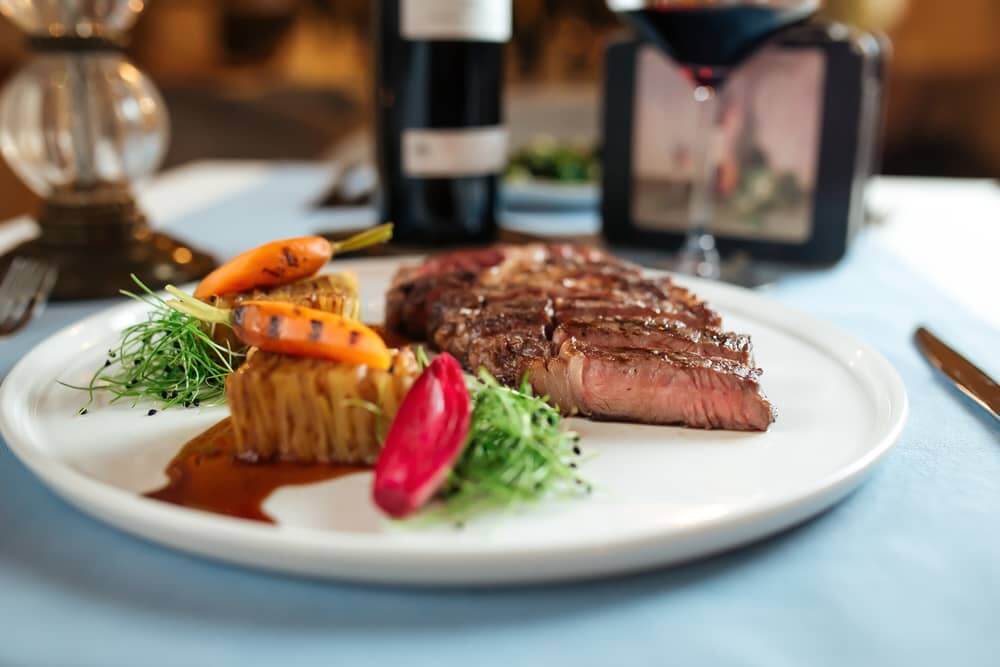
Cooking Time and Temperature
Cooking time and temperature are critical factors in achieving a perfectly cooked ribeye steak. The cooking time will depend on the thickness of the steak and the level of doneness you prefer. For a medium-rare steak, cook the ribeye for about 3-4 minutes per side, or until it reaches an internal temperature of 130-135°F (54-57°C). If you prefer a medium steak, cook for 5-6 minutes per side, or until it reaches an internal temperature of 140-145°F (60-63°C).
To ensure accuracy, use a meat thermometer to check the internal temperature of the steak. Insert the thermometer into the thickest part of the steak, avoiding any fat or bone. This will give you a precise reading and help you achieve your desired level of doneness.
Common Mistakes to Avoid
There are several common mistakes to avoid when cooking a ribeye steak. One of the most frequent errors is overcooking the steak, which can make it tough and dry. To prevent this, always keep an eye on the cooking time and use a meat thermometer to check the internal temperature.
Another mistake is not letting the steak rest after cooking. Allowing the steak to rest for 5-10 minutes after removing it from the pan lets the juices redistribute throughout the meat, resulting in a juicier and more flavorful steak.
Finally, avoid pressing down on the steak with your spatula while it’s cooking. This can squeeze out the juices and make the steak tough. By following these tips and avoiding common mistakes, you can achieve a delicious and juicy ribeye steak that’s sure to impress.
Summing Up: How to Cook Ribeye in a Pan
Hopefully, this guide helps you feel prepared to cook ribeye in a pan at home in just a few minutes. Make sure you start with high-quality steaks that yield the best results, like those from Chicago Steak Company. Try our best-selling ribeye steaks that are ready to order online and ship quickly and safely to your door.

